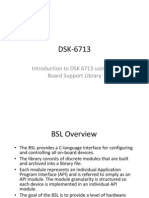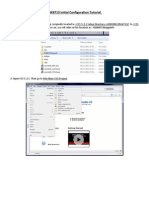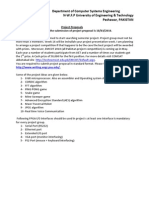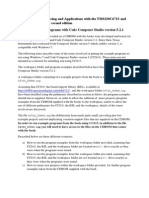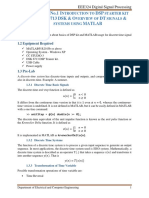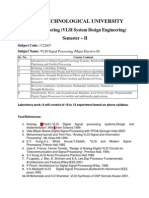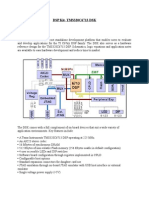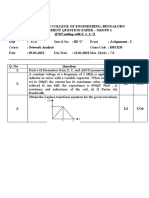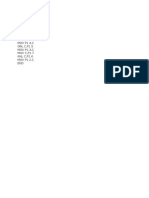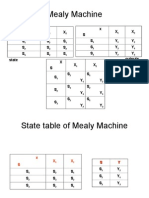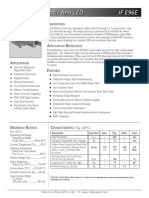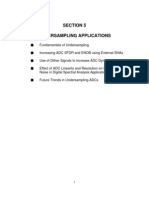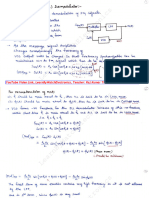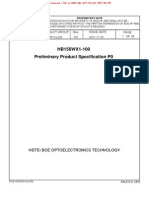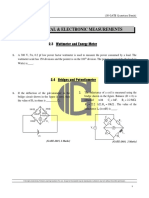DSP-6713
DIGITAL SIGNAL
PROCESSING LAB
�DSP PROCESSOR KITS
TYPES
OF PROCESSOR KITS
TMS320C6711
TMS320C6713
TMS320C6716
�TMS320C6713
C6713 DSK Board
+5v Universal power supply
AC Power cord
USB Cable
�BLOCK DIAGRAM-DSP
6713
�DSP 6713-Features
It
is a floating point DSP running at 225MHz.
The basic clock cycle instruction time is 1/(225
MHz)= 4.44 nanoseconds.
During each clock cycle, up to eight instructions
can be carried out in parallel, achieving up to
8225 = 1800 million instructions per second
(MIPS).
The C6713 processor has 256KB of internal
memory, and can potentially address 4GB of
external memory.
�Contd..
The
DSK board includes a 16MB SDRAM
memory and a 512KB Flash ROM.
It has an on-board 16-bit audio stereo codec
that serves both as an A/D and a D/A
converter.
There are four 3.5 mm audio jacks for
microphone and stereo line input, and speaker
and head-phone outputs.
The DSK also has four user-programmable DIP
switches and four LEDs that can be used to
control and monitor programs running on the
DSP.
�Contd..
All
features of the DSK are managed
by the CCS which is a complete
integrated development environment
(IDE)
It includes : An optimizing C/C++
compiler
Assembler
Linker
Debugger
Program loader.
�Contd..
The
CCS communicates with the
DSK via a USB connection to a
PC.
The CCS can also read signals
stored on the DSPs memory, or
the SDRAM, and plot them in the
time or frequency domains.
�Contd..
225
MHz TMS320C6713 floating point DSP
AIC23 stereo codec (ADC and DAC)
Ideal for audio applications
8-96 kHz sample rates
Memory
16 MB dynamic RAM
512 kB nonvolatile FLASH memory
General purpose I/O
4 LEDs
4 DIP switches(Dual Inline Package Switch)
USB
interface to PC
�Contd..
����AIC23 CODEC
The
DSK uses stereo codec for input and
output of audio signals.
The codec samples analog signals on the
microphone or line inputs and converts
them into digital data.
Codec communicates with two channel
(i)to control the codecs internal
configuration registers
(ii)to send and receive digital audio
samples.
Codec has 12MHz clock
�CPLD
CPLD:Complex
Programmable Logic
Device
It has 4 memory mapped
control/status
registers that allow
software control of various board
features.
Control of the daughter card
interface and signals.
Assorted glue "logic that ties the
board components together.
�CPLD Registers
These
Registers allows users to control CPLD
functions in software.
These registers are primarily used to access
the LEDs and DIP switches and control the
daughter card interface.
TYPES
OF REGISTERS
USER-REG
Register
DC-REG Register
VERSION Register
MISC Register
�USER-REG Register
USER-REG
is used to read the
state of the 4 DIP switches and
turn the 4 LEDs on or off to allow
the user to interact with the DSK.
The DIP switches are read by
reading the top 4 bits of the
register and the LEDs are set by
writing to the low 4 bits.
�DC-REG Register
It
is used to monitor and control
the daughter card interface.
It also detects the presence of a
daughter card.
It also provide simple
communications with the
daughter card through readable
status lines and writable control
lines.
�VERSION Register
This
register contains two read
only fields that indicate BOARD
and CPLD versions.
This register will allow the
software to differentiate between
production releases of the DSK
and account for any variances.
�MISC Register
This
register is used to provide
software control for
miscellaneous board functions.
On the 6713DSK,the MISC
register controls how auxiliary
signals are brought out to the
daughter card connectors.
�SDRAM
SDRAM-Synchrronous
Dynamic
Random Access Memory
DSK uses a 128 mega bit SDRAM
on the 32 bit Processor.
SDRAM must be configured in
software for proper operation.
�FLASH MEMORY
Flash
is a type of memory which does
not lose its contents when the power is
turned off.
It can be erased in large blocks
commonly referred to as sectors or
pages.
Once a block has been erased each word
can be programmed once through a
special command sequence.
The DSK uses a 512K byte external flash
as a boot option.
�LEDs and DIP switches
DSK
includes 4 LEDs and DIP
switches.
It provide the user a simple form
of input/output.Both are accessed
through the CPLD USER-REG
register.
�DAUGHTER CARD INTERFACE
The
DSK provides three expansion
connectors that can be used to
accept plug-in daughter cards.
The daughter card allows users to
build on their DSK platforms to
extend its capabilities and provide
customer and application specific I/O.
There are three expansion connectors
(i)memeory (ii) peripherals (iii) Host
Port Interface(HPI)
�CONTD..
The
memory connector provides access
to the DSPs asynchronous signals to
interface with memories and memory
mapped devices.
The peripheral connector brings out the
DSPs peripheral signals like clock,
timers etc.
The HPI is a high speed interface that
can be used to allow multiple DSPs to
communicate and cooperate on a given
task.
�JTAG-Emulator
JTAG:
Joint Test Action Group
Emulationrefers to the ability of a
computer program in an electronic
device toemulate(imitate) another
program or device.
JTAG emulators designed specifically
for TI's Code Composer Studio debug
tools.
It is mainly used to drive the CCS.
Allows for emulation hardware and
software to communicate with the DSP.
�DIP SWITCHES
A
series of tiny switches built
intocircuit boards. The housing
for the switches, which has the
same shape as achip, is theDIP.
DIP switches enable you
toconfigurea circuit board for a
particular type ofcomputer
orapplication.
�Is my DSK working?
DSK Power On Self Test
Power
up DSK and watch LEDs
Power On Self Test (POST) program stored in
FLASH memory automatically executes
POST takes 10-15 seconds to complete
All DSK subsystems are automatically tested
During POST, a 1kHz sinusoid is output from the
AIC23 codec for 1 second
Listen with headphones or watch on oscilloscope
If POST is successful, all four LEDs blink 3 times
and then remain on
�Is my DSK working?
DSK Diagnostic Utility
Install
CCS 3.1
Directions in Quick Start
Installation Guide
Diagnostic utility automatically
installed
�Code Composer Studio
IDE
Connect
power supply to DSK
Wait for POST to complete
Connect USB cable from PC to DSK
If this is the first time connecting the DSK, you
may be asked to install a driver. The driver is
on the Code Composer Studio CD and will
automatically be found by Windows if the CD
is in the drive.
Launch Code Composer Studio C6713 DSK
CCS will load and wait for your input
�Code Composer Studio
IDE
�CCS Integrated Development
Environment
�Connecting to the C6713 DSK
�Opening an Existing Project
Project->Open
�Compiling/Building a Project
Project->Build (F7)
�Loading and Running a Project
on the C6713 DSK






